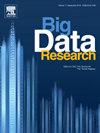Classifier-Based Nonuniform Time Slicing Method for Local Community Evolution Analysis
Abstract
With the rapid expansion of the scale of a dynamic network, local community evolution analysis attracts much attention because of its efficiency and accuracy. It concentrates on a particularly interested community rather than considering all communities together. A fundamental problem is how to divide time into slices so that a dynamic network is represented as a sequence of snapshots which accurately capture the evolutionary events of the interested community. Existing time slicing methods lead to inaccurate evolution analysis results. The reason is that they usually rely on a linear strategy while the community evolution is a nonlinear process. This paper investigates the problem and proposes a classifier-based time slicing method for local community evolution analysis. First, a classifier is trained for judging whether there is a community in the given network snapshot is identified as the continuing of the community defined by the given node subset. The features for classification include internal cohesion degree and external coupling degree. Second, a time slicing method is proposed based on the trained classifier. As the network evolves, the method continuously uses the classifier to predict whether there is a community in the newest network identified as the continuing of the interested community. Whenever the answer is negative, an evolutionary event is presumed to have occurred and a new time slice is generated. Experimental results show that compared with existing time slicing methods, our proposed method achieves higher recognition rate for given redundancy ratio.

 求助内容:
求助内容: 应助结果提醒方式:
应助结果提醒方式:


